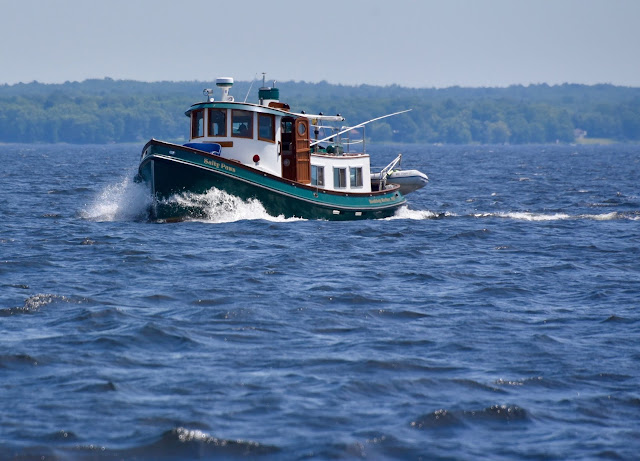 |
| Local antiques proprietress willing, er ... anxious to talk politics |
ST JOHNSVILLE, NY With an expected two-day wait, we soaked up the offerings of the town deemed to have the best drinking water - 19 years ago. We never would have known about it if it didn't have a municipal marina and campground.
 |
| Bakery in St Johnsville - as good as it gets |
 |
| Pump out: the dirty reality of boat life |
Fortunately, someone realized the value of boaters, for needs and the necessities of life.
 |
| Leaving St Johnsville |
By now we were veterans of managing the unexpected, and it came as no surprise when we received a notification from the canal authority that the locks west would be opening at noon - this day! We scurried back to the boats and cast off.
Traveling west we passed under one of the guard gates which had been closed during the heavy rains in order to help control the excess water and preserve the locks. Our experience in the last three days gave deeper appreciation of their importance.
The canal is extremely well-maintained, with buoys marking the navigable channel, copious distance markers, canal boats with fresh paint, as are the buildings at the locks. Lawns are mowed and trimmed. They welcome visitors, fishermen, picnickkers, and even campers in some locations. I There's even a 365 mile bike path running the entire length from Buffalo to Albany. It's a huge resource for the State of New York, and was recently named a National Heritage Corridor. Today the canal is used primarily by recreational boaters, who pay a use fee. (Except this year it's free to mark the 200th anniversary.) Could those fees possibly cover the expenses?
No. But its historic importance speaks for itself.
Approaching lock 17, boats enter via a lift gate instead of the usual swinging doors called mitre gates.

Lock 17 has a lift of 40.5 feet, the highest on the canal and one of the highest in the world.
This was the last lock of the day and we stopped in the town of Little Falls for the night. Little Falls is more populous and prosperous than St Johnsville. But the beautiful old mills no longer sound with the hum of machinery. They are apartments and antique centers.
 |
| Masonic Hall |
Real estate prices tell the story. The Masonic Hall sold in May for $350,000.

And then there's the story of the blue house, shown on the left. This row of houses sits at the base of a limestone cliff, one of many found throughout this region (Read John McPhee's book: Basin and Range). Sound cozy? Hmm. One night a bit of the cliff gave way sending a large amount of rock crashing through the blue's roof and continuing right on down to the basement, killing an unsuspecting occupant who was sleeping at the time. Oops!

MOXIE MOMENT: She took a liking to this redneck pickup.

Navigating the canal route on the scenic Mohawk River
Back on the water. Today's canal route is not that of the original Erie Canal completed in 1825. The first waterway was such a success on many fronts that the 40 feet wide x 4 feet deep dimensions couldn't accommodate the high demands of traffic, and the canal was enlarged several times. In 1903 it was determined that a barge canal would be built using watercourses along the route. Hence, the use of the Mohawk River from Troy to Rome.

From Rome to Oneida Lake, the canal follows the dug "landline" of the original Erie. The is where the digging of the canal began 200 years ago. Today, it's a long straight stretch.

Once again, the canal route took advantage of Lake Oneida, a 20-mile long stretch. What a change! Waves of the freshwater variety.

Two more locks before we turned off the Erie onto the Oswego Canal. It was common to share a lock with other boats, many of which were undertaking the Great Loop, circumnavigating the eastern half of the United States. This venture takes an average of one year, and most boats were of substantial size to provide some of the creature comforts of home life. Some! We met this guy who was doing the loop in this inflatable. He'd come from Florida and so far, so good.
|

You meet a lot of interesting people. This couple, flanked by Jeanne and Allan, weren't doing the loop. That venture sounded rather tame compared to their cruising exploits. Larry and Bev Mosser sailed their 55 foot Teyana sailboat around the world for 15 years stopping in ports for months at a time. Why the lengthy stops? Bev explained that you can sail around the world and just see water. That's not seeing "the world." We all agreed.
We left the Erie Canal just before Syracuse and turned north up the Oswego River to Lake Ontario.
Sadly, we said goodbye to Tom Collins who headed back to Colorado to continue planning his dream to cross the US by water. He's done a lot of research, scouted the waterways, and hopes to convince his wife to join him. We were happy to allow him to put the Hudson River and part of the Erie Canal in the "Done" column.
The end of the Oswego Canal with Lake Ontario on the horizon.
And now for the reality check. Many of you already know that we had to make a temporary change of plans. Sally and Allan left Sally W in Oswego (for a week) and went home to Vermont to recover from a virus contracted early on the journey up the Hudson. Jeanne, Bob, and Moxie continued up into Canada.
Captain Bob and Jeanne preparing to explore Lake Ontario and beyond.
The good news is that Sally and Allan have since returned to their tug and plan to travel the Erie to the eastern terminus, and travel north through Lake Champlain to meet Salty Paws as she exits Canada back into the US. All is not lost. Stand by.
|
|























No comments:
Post a Comment